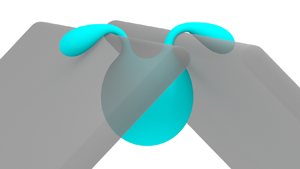Article contents
Drop squeezing between arbitrary smooth obstacles
Published online by Cambridge University Press: 10 December 2020
Abstract

A fully three-dimensional boundary-integral method (BIM) is developed for the interaction of drops, suspended in a uniform far-field flow at small Reynolds number, with arbitrary Lyapunov surfaces. The close approach of fluid interfaces to solid surfaces poses significant challenges for numerical BIM implementations, due to the highly singular behaviour of single- and double-layer boundary integrals. Two new methods are described that generalize the accurate calculation of the highly singular surface integrals used by high-order desingularization techniques. The first method is semi-analytical, and applies to axisymmetric solid obstacles (in an arbitrary three-dimensional configuration). An axisymmetric particle can be divided into a series of characteristic disks along its axis, for which closed-form expressions for single and double layers are derived in terms of elliptic integrals. To accommodate arbitrary smooth surfaces, a multimesh desingularization method is introduced that calculates surface integrals utilizing a hierarchy of embedded mesh resolutions, together with distance-activated mesh interactions. Several particle shapes, including spherocylinders (capsules) and flat plates, are used to represent major classes characteristic of porous media. A droplet approaching a capsule will break up after forming two lobes, connected by a thin filament, on either side of the capsule. The cross-sectional shape of the filament affects lubrication behaviour. A constriction made of two parallel capsules, even of low aspect ratio, significantly retards drop passage compared to two spheres. Trends in drop squeezing between two capsules are summarized over a range of capillary number, viscosity ratio, drop size and capsule length. A constriction of two coplanar plates results in notably different lubrication and squeezing behaviour. Flow rectification is demonstrated for constrictions that are non-symmetrical with respect to flow reversal, for several non-axisymmetric particles.
Information
- Type
- JFM Papers
- Information
- Copyright
- © The Author(s), 2020. Published by Cambridge University Press
References
REFERENCES
- 9
- Cited by


